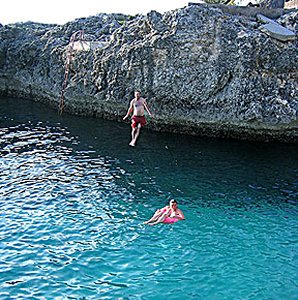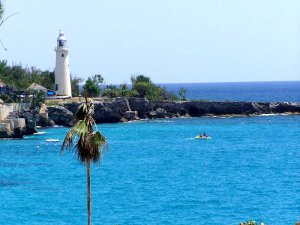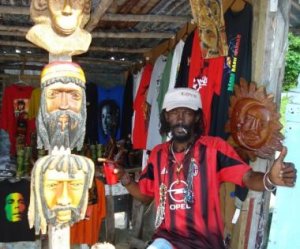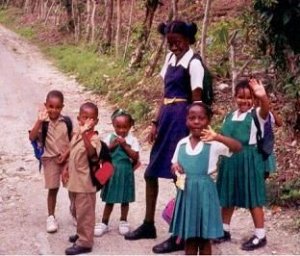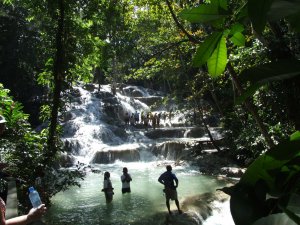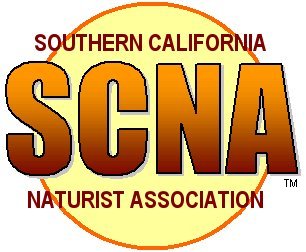
|
SCNA TRAVEL CORNER Travel Menu | So Cal Beaches | Hot Springs | Hiking | Other States | Cruises | Foreign Lands |
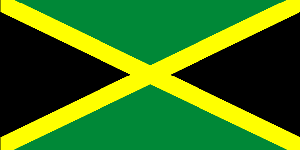
|
By Gary Mussell
Author’s Note: This trip was taken from October 26 to November 1,1990. Obviously much has changed during the twenty years since, such as the dollar exchange rate and the relative quality of the hotels (some new, some better, some worse). Take this travel report as a general observation only and have your own adventure!
There is no way I can hold myself out as an expert on Jamaica after just a week on that sultry and alluring island, so I will confine myself here to just my observations and the conversations I had with the persons I met during my week in "Paradise."
My first thought is to the wide gap between the Jamaica promoted in the travel brochure (the ones showing smiling black faces serving banana daiquiris to a smiling pair of young lovers with swim masks on their heads), and the Jamaica I saw of a people with stoic but proud faces, walking the pot-holed roads to work each day so their families might eat that night. Tourists who come to the island seem to be expecting grass skirts and Polynesian dancers. They pay their $1500 to stay in a hotel complex designed to treat them like royalty. But beyond their great walls of coconut palms and ignorance lies a beautiful third world country, poor and heavily in debt, still struggling to rebuild from the destruction of Hurricane Gilbert two years ago, with few exportable goods except rum, coffee, sugar cane and luring tourists to their beautiful translucent-blue beaches.
It was a shock to me to be greeted by so many aggressive taxi drivers as I stepped outside Montego Bay airport, all of them asking my name and wanting to shake my hand. I learned Jamaicans do this a lot , but it is a genuine friendliness, not just a come-on for business (although it is that also), so one should always smile and shake back.
Many tourists rent cars at the airport, but you need to inspect the vehicle carefully as most of them are several years old with a missing light, split seat, or bad window wiper. Don't look for a perfect car to rent because it doesn't exist there. Always get as small a car as you can because the larger ones all have dents and crushed corners from being larger targets on the road (more on this below.) An average rental (1990 dollars) wa $50-75/day US currency.
The current rate of currency exchange is 8 Jamaican to 1 US dollar, but the gap is getting wider almost monthly. Get as much converted cash at the airport as you think you will need for the trip because finding authorized places to change money is hard in the countryside. Those few restaurants that will accept U.S. Traveler's Cheques usually shave off a few tenths off the exchange rate (Rick's Place in Negril gave me 7.5 to 1, for example.)
It is real shock to have to pay JA$100 for 1/2 tank of gas (Shell and Texaco seem to have a lock on the service stations) and JA$185 for a good dinner, but you get used to it. Almost all places will post both Jamaican and US prices, but be aware that tourists generally pay a little more for food and souvenirs above the "Jamaican rate" simply because they are not native Jamaicans.
There are street urchins willing to exchange U.S. bills for Jamaican currency at black market rates but it is illegal and risky. Tipping using US currency I found gives you a better cut of meat or bigger portion or better service the second time you eat anywhere. They do remember you!
Everywhere I went during these six days, which was between Negril on the West coast and Ocho Rio on the North, a distance of just over 3 hours by car, I saw people walking alongside the roads. In groups of threes and fours usually, spaced out every hundred yards or so, walking to someplace or from someplace. Most were tall and lean, as many men as women. Some carried water in open containers on their heads or in recycled anti-freeze jugs. Some just stood and silently watched the traffic go by.
All the boys walking the roads near the state-run schools were in uniforms of light brown, military-style. The girls wear uniforms of differently solid colors, mostly maroons or yellows or dark blues, based on the primary or secondary school they attended.
To be sure, there are some motor bikes and bicycles and some cars, but most people just seem to walk. There are authorized red-licensed plated mini-vans that act as the public transportation but there are no official loading or unloading zones, so these vans just stop whenever they want to, often right in front of you, with no warning. Drivers beep their horns at every curve and at almost every other car. Passing the car in front of you is a national sport, but these are 2lane, curbless highways, so passing a car means risking a head-on collision with on-coming traffic on these curving, narrow roads. Not for the faint hearted! When the rains come every afternoon for about an hour, the streets puddle up and the water has nowhere to go, adding extra obstacles for a driver.
I saw T-shirt and conches shell stands every few miles, thick green foliage that came right to the road, and open green fields containing underfed cattle, coconut trees, or sugar cane. There are small, open-air shacks selling hot spicy jerk (chicken, beef, or pork), breadfruit, boiled bananas and rum along the road too. Everyone seems to own goats or dogs or a donkey or all three. Some of the trees had their tops blown away when Gilbert struck so they stand in rows looking like a crop of telephone poles about to be harvested. There are great houses on the hillsides, like Rose Hall, left from the colonial days when the British ruled here, and there are small 1-room shacks with tin roofs assembled in small clusters near the roadside.
There is also seen an occasional carcass of an automobile, rusted and abandoned. Nothing is thrown away here, any working parts are taken to fix another vehicle so that some cars on the road resemble nothing like what they did when originally purchased 10-20 years ago. I even saw a formerly single engine airplane, with wings still intact, beached near the road and hollowed out, because someone is using it as a home.
Jamaica has several must-see attractions for tourists that I did not have time to visit, unfortunately, including riding the flat bamboo rafts down the Rio Grande and exploring some of the caves and waterfalls. Costs for admission to these places, plus to hire a taxi driver to take you there and wait and then return you to your hotel is about US$80 per couple. Have the hotel arrange the transportation for you as they know the reputable drivers.
Montego Bay is the tourist shop mecca of the north and west. It is crammed with people selling everything imaginable, narrow streets, traffic that makes New York City look tame, and propagandistic billboards reminding Jamaicans to "Treat tourists right" and to "Produce more." I was told everyone wants your money there and will steal it if you are careless. Money belts are a must and don't leave anything in your hotel that you don't want stolen, even toilet paper. As in most countries, only a few natives wish you harm, but the danger is real enough that one needs to be overly cautious, at least in Montego Bay and Kingston. I met several vacationing couples in Negril who had come there simply to get away from the crush of Montego.
The hotels near Montego (like Sandals, Holiday Inn, and Half Moon) are strung out for 10 miles, mostly to the west of the city on highway 1A. There isn't much outside these hotels to do, besides golf, that doesn't require a car and committing an hour of time to get there.
When you travel outside, such as to Ocho Rios and it's upper scale shops and trade bazaars, remember such minor conveniences as radio batteries, finger bandages, and even aspirin are in short supply and you should pack what you need for the trip. Pepsi is the national pop, but all bottles are recycled, the caps are too, so the drinks taste a bit flat and I found rust around the tops of a few, so use a clean straw. The fish is always fresh that day, and the baked breads and exotic fruits and berries are wonderful to discover. Evita's for a pasta dinner is a recommended spot in Ocho Rios, but many cuisines are around, even a Burger King!
Between Ocho Rios and Montego Bay is Discovery Bay, where Columbus landed in 1494, and Runaway Bay, site of several new resorts like Jamaica Jamaica, Club Caribbean, and FDR. I stayed at Sea Spray, a no-frills complex where the food is wonderful and the rates are half what they are anywhere in that area. Club Caribbean has a small nude beach but the shore is rocky with dark, coarser sand than at Montego or Negril. FDR is a new, family oriented hotel with sail boats for rent and scuba lessons every afternoon. This central part of the north shore seems to get more rain and wind in the Fall, and has a rockier shoreline and higher waves than the western side of the island. There is lots of coral to explore just offshore, and one can see the large cruise ships transversing the coast in the distance.
I have saved the best for last, my two days in Negril, with its seven miles of white sand and world-famous resort hotels. Most of the resorts are just north of the town and they line the water, blocking it from view from the road. By law, no building can be taller than three stories, but these enclaves of stark white walls and clay roofs are a startling contrast to the rest of the rolling green countryside.
The "big three" (Grand Lido, Hedonism II, and Sandals) sit side-by side and stretch for about a half a mile with beaches that have been blocked off from outsiders. Grand Lido is a “treat-you-like-a-king” 5star hotel, Hedonism is the a clothing optional resort, while Sandals is for couples only. Just south of them are two other hotels, the Poincana and Mahogony Inn, which looked nice from the outside but by local reputation are not in the same league at the first three.
The freshest looking, and apparently one of the newest, is Swept Away, with tennis courts, a conventional hall and restaurant complex on the east side of the road (away from the water) and the rest of the complex along the beach. It is far more "open" in looks than the others, with reds and pinks its color motifs. Most of their buildings contained eight apartments, 2 below and 2 above on each side.
Its beach was open to others as well, but uniformed guards keep the ever-present T-shirt and massage vendors away from the area. These vendors line the road across the street practically the entire length of the northern hotel area, selling shells, jewelry, carved bric-a-brac, and shirts and pants with any color, decal, or phrase you can imagine. They don't take no for an answer easily.
I stayed at the Negril Cabins, across from the Grand Lido and it is a real bargain for someone who wants a nice, no-frills place to sleep without a telephone. About US$49/night. Best low-budget food in town is at Country, near TreeHouse, south of Swept Away. Half the price and twice the portions. They also cook US$4/plate lunches and dinners on the beach. This is the location of what I was told is one of the longest continuous-running dominoes games in Negril. Dominoes is a national passion (as is soccer), and it takes much skill to keep up with these no-holds-barred veterans.
I found Rick's Place, located in town near the high diver bluffs to be pricey (US$165/meal average) and the food quality only okay. You definitely pay for the view of the sun setting next to the open air bar, sipping your rum punch, but, that IS what you go there for anyway.
The waters in Negril are indescribably beautiful. Clear and 85 degrees, with hardly any waves at all. You can walk out for 100 yards and still only be up to your shoulders and see your feet on the bottom. Among the European visitors that I met, especially Italians and Germans, there is a natural desire to remove most of their clothing and swim topless with little string bikini bottoms. There is a nude beach just north of Swept Away called Bloody Beach, but it is sparsely used, I think primarily out of fear one's pants will be swiped!
Americans seem more uptight about showing skin, with many US women, especially those over about 30, wearing 1 piece suits and elbowing their husbands to stop looking at the Europeans. Water skiers, jet skiers, and parachute skiers are everywhere, as are the Jamaican vendors promoting these activities, speaking in their Reggae-syncopated version of English. Phrases I heard most often were "No Problem", "No pay to look" (at a vendor's T-shirt display), and "What you name, Mon?" Bob Marley is the island's patron saint of reggae music. There are few radio stations and reggae-versions of American rock standards are often played.
Lastly, remember to bring a passport even though none is technically required. [Author's Note: It is now, 20 years later.] It will speed your return through customs (this can take from 30 minutes to two hours, depending on the lines in Miami.) Jamaica charges a US$10 departure fee at the airport when you go. Remember to drive on the left side of the road. Bring mosquito repellent and high-number sun block (the sun is so intense that block #15 works like a #4 in the states.)
One last stop is a must: the duty free shops at the airport. Fill what space remains in your travel bags with Blue Mountain coffee and a couple bottles of duty-fre rum. In the entire world, there is nothing like genuine Jamaican coffee or rum!
I strongly urge to to escape from the tourist enclaves and see the beautiful country, meet the real people, and eat the local food dishes. This may require you pay a local a few dollars to act as your guide, to get you past the rougher areas of town, and to point out the better places to eat and relax. The experience is well worth it!
|
